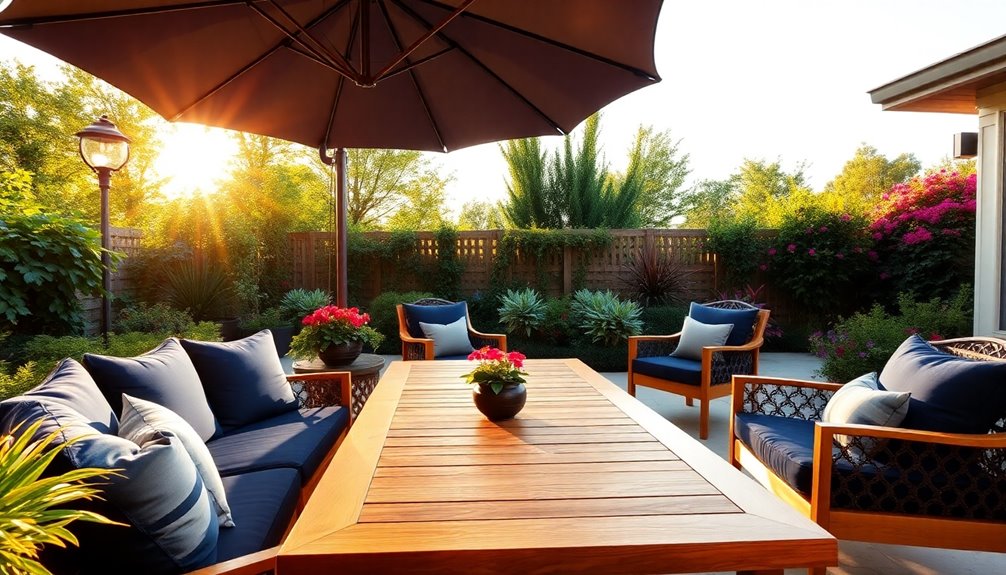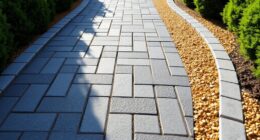The secret to choosing the right outdoor furniture lies in understanding your space and needs. Start by measuring your area and determining how you'll use it—whether for dining, lounging, or entertaining. Select durable materials like teak or aluminum to ensure longevity. Mix styles and textures to create a cohesive look that reflects your personal taste. Comfort's essential, so prioritize ergonomic options with soft cushions. Lastly, consider maintenance and budget to avoid surprises later. By following these guidelines, you can create a beautiful and functional outdoor oasis that suits your lifestyle perfectly. There's plenty more to explore!
Key Takeaways
- Assess your outdoor space dimensions and functions to create effective zones for dining, lounging, or entertaining.
- Choose durable, weather-resistant materials like teak, aluminum, or recycled plastics for longevity and aesthetic appeal.
- Prioritize comfort by selecting ergonomic designs and investing in thick, weather-resistant cushions for support.
- Create a cohesive design by unifying colors and textures while mixing styles for visual interest.
- Plan for maintenance needs and consider design trends like minimalist styles and sustainable materials for long-term satisfaction.
Assess Your Outdoor Space
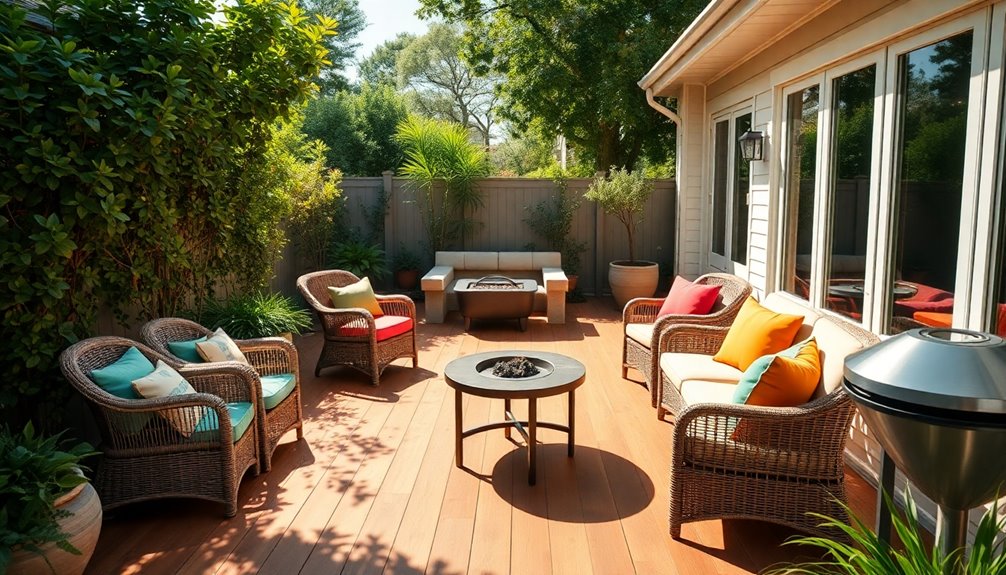
How do you make the most of your outdoor space? Start by measuring the length, width, and depth of the area.
Pay attention to any obstructions like plants or pathways that could influence your furniture arrangement. Visualize where you want to place your furniture to ensure a comfortable flow.
Consider the primary functions of the space—whether it's for dining, lounging, or entertaining—and plan your layout accordingly. Create zones for different activities and choose flexible furniture that can adapt. Proper measurements are essential to ensure a comfortable outdoor experience that enhances usability.
If your space has an irregular shape, measure its longest and widest points, and think about using modular pieces for a tailored fit.
These steps will help you optimize your outdoor area for maximum enjoyment.
Choose the Right Materials
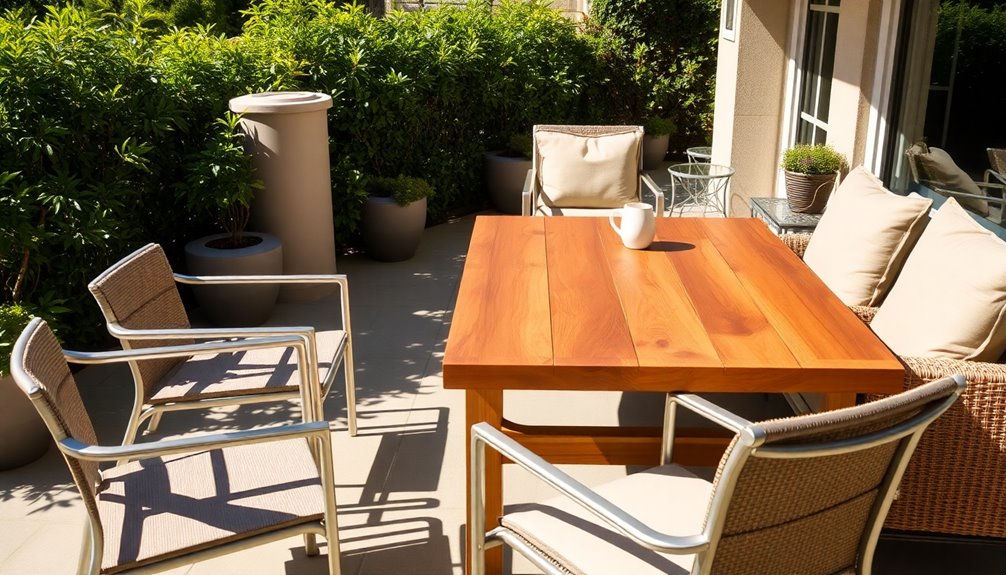
When selecting outdoor furniture, consider the materials carefully, as they play a crucial role in durability, aesthetics, and maintenance.
For instance, teak is naturally resistant to decay and moisture, making it a beautiful and long-lasting choice. Aluminum is lightweight and rust-resistant, ideal for fluctuating weather. Additionally, high-quality materials ensure that your furniture withstands various weather conditions and wear from pets and children. Using eco-friendly materials not only enhances your outdoor space but also supports sustainable harvesting practices.
If you want something highly durable, GRC combines the strength of concrete with fiberglass flexibility. HDPE lumber is another fantastic option since it doesn't warp or crack, plus it's made from recycled materials.
For a stylish touch, all-weather wicker can withstand humidity without mold.
Ultimately, the right material ensures your outdoor furniture looks great and stands the test of time, requiring minimal upkeep while enhancing your space's aesthetic appeal.
Combine Styles and Textures
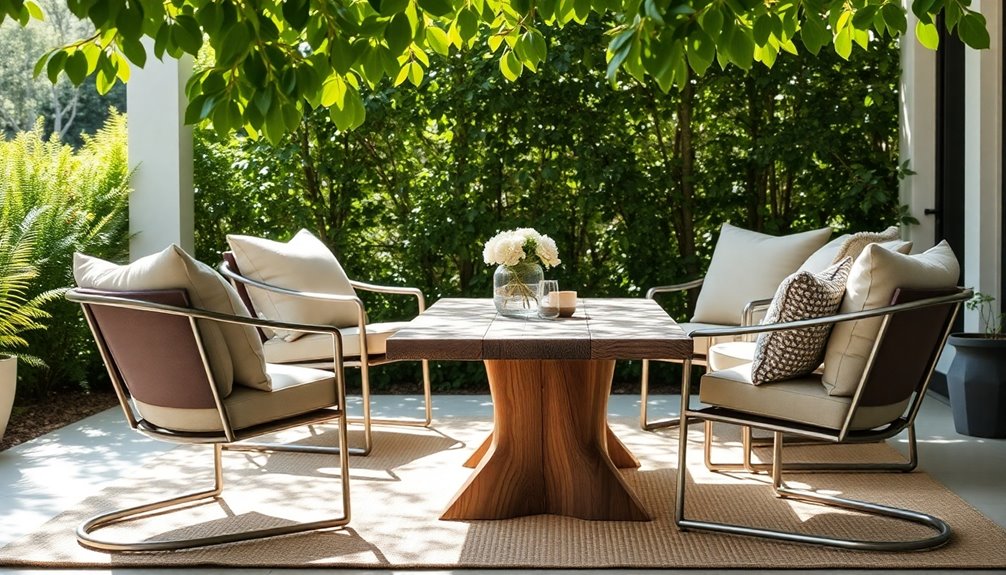
Combining styles and textures in your outdoor furniture can transform your space into a visually captivating retreat. Start by selecting a common thread, like coordinating colors or materials that complement each other. Mixing different sizes and scales helps achieve balance, so pair small seating with larger pieces for an inviting look. Don't shy away from contrasts; combine modern styles with vintage accents or mix materials like wicker and metal to create depth. Incorporating a range of colors and textures adds visual depth to patio spaces. Use decor to unify the mix-and-match aesthetic—repeat colors in pillows and rugs, or incorporate natural elements like plants. Additionally, consider adding rustic charm through the use of reclaimed wood in your furniture pieces to enhance the overall aesthetic. Lastly, enhance the ambiance with lighting accessories, tying everything together while adding warmth to your outdoor haven. Your outdoor area will feel cohesive and stylish!
Prioritize Comfort

Prioritizing comfort in your outdoor furniture is essential for creating a relaxing space where you can unwind and entertain.
Look for ergonomic designs that support your posture, like curved backs and contoured seats. Choose durable materials, such as teak or outdoor-grade rattan, that also offer comfort. Comfortable environments can enhance enjoyment of fresh air and nature, making your outdoor area a true retreat. Additionally, consider how energy monitoring features can help you manage outdoor heating or cooling options efficiently.
Ensure the furniture fits well in your space, allowing for easy movement and a spacious feel. High-quality cushions are crucial; go for thick, weather-resistant options that support your head, neck, and back.
Consider adjustable features, like reclining chairs and customizable cushions, to tailor comfort to your needs.
Always test furniture in-store or read reviews to gauge its comfort and durability before making a purchase. Your outdoor oasis deserves it!
Plan for Maintenance
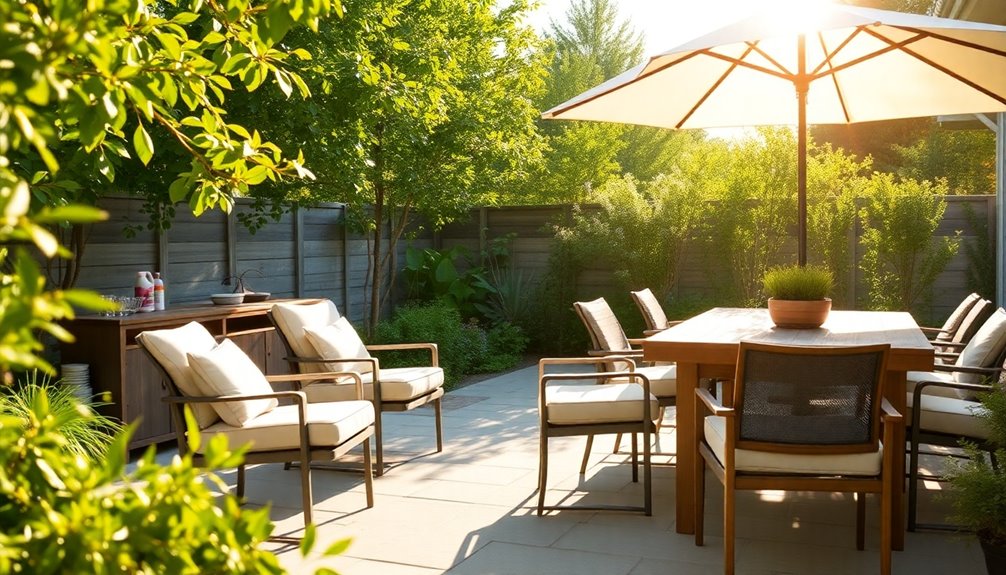
Comfort plays a significant role in your outdoor experience, but maintaining that comfort requires a solid plan for upkeep.
Start with regular cleaning; wipe down your furniture weekly to keep dirt at bay. Check cushions for stains and spot clean immediately. Consider using a handheld vacuum for quick clean-ups in outdoor spaces.
Every few months, deep clean with mild soap and a soft-bristle brush, thoroughly rinsing afterward. Protect your furniture with UV sprays for fabrics and water-repellent treatments for wood. Proper material selection reduces maintenance needs and extends furniture lifespan.
Store cushions indoors and use weather-resistant covers for the furniture to shield it from the elements. Regularly inspect stored items for moisture and address any issues promptly.
Account for Climate
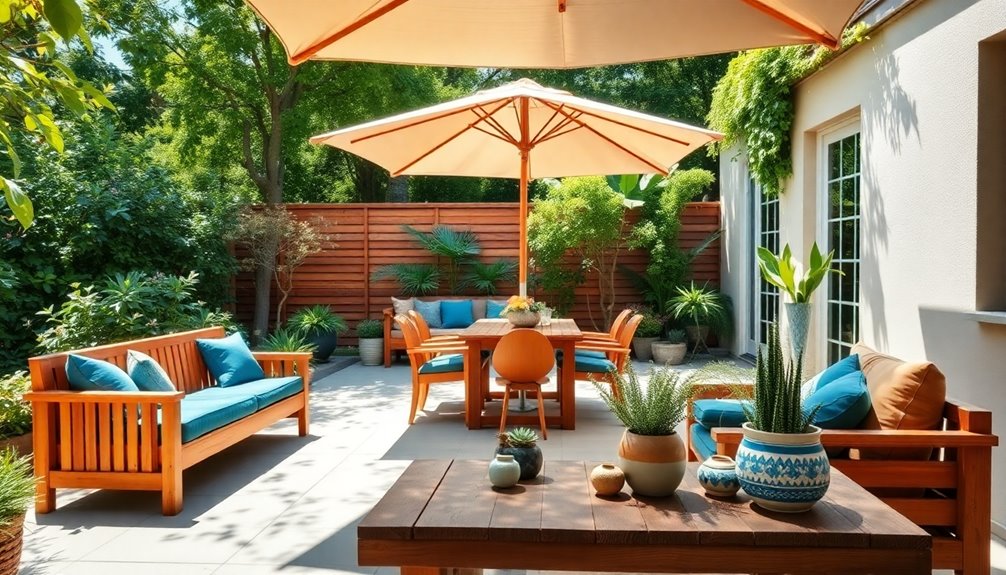
When selecting outdoor furniture, it's crucial to account for your local climate, as this will significantly impact both the durability and comfort of your pieces.
Begin by evaluating temperature fluctuations, humidity levels, and precipitation patterns in your area. For instance, if you live in a humid zone, opt for mold and mildew-resistant materials like teak or resin wicker. Additionally, consider that appropriate material selection enhances the lifespan and aesthetic appeal of your furniture throughout the seasons.
In colder climates, cast aluminum or wrought iron are excellent choices due to their resistance to freezing temperatures.
Also, consider wind and sunlight; heavier furniture can withstand strong winds, while UV-protected fabrics help prevent fading.
Set a Budget
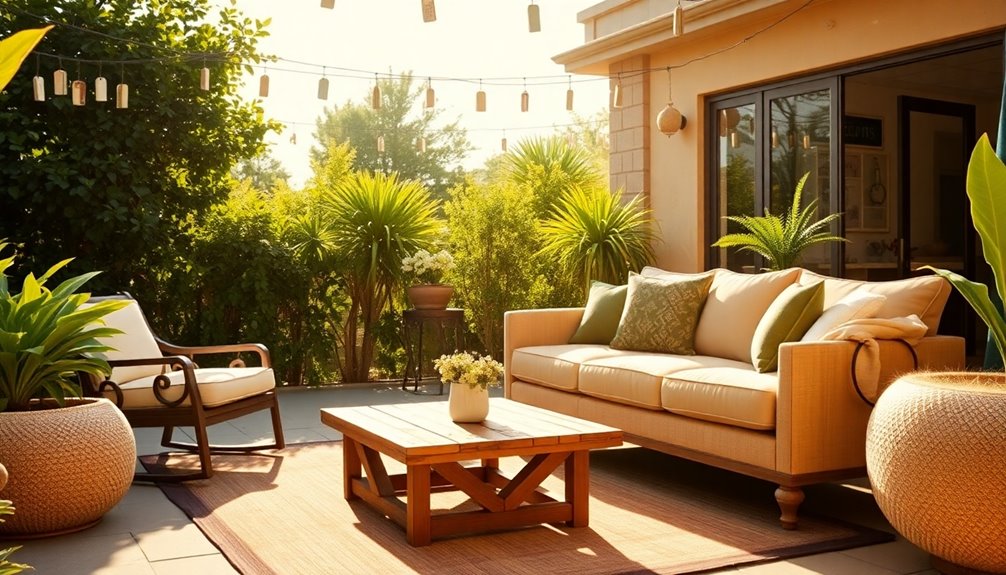
Setting a budget is essential for making informed decisions about your outdoor furniture. Start by determining a realistic budget range based on average costs.
Remember, high-quality furniture might've a higher upfront price but can save you money over time. Prioritize essential items like dining tables and lounge chairs before considering accessories.
Measure your outdoor space to assess how many pieces you need and consider the number of users. Don't forget to budget for cushions and umbrellas.
Keep an eye out for sales to stretch your budget further. Finally, balance quality with cost—investing in durable materials can reduce future replacements and ensure your outdoor furniture lasts for years. Additionally, consider the investment in quality as it reflects not only in the durability of your furniture but also in the overall comfort and style of your outdoor space.
Explore Design Trends
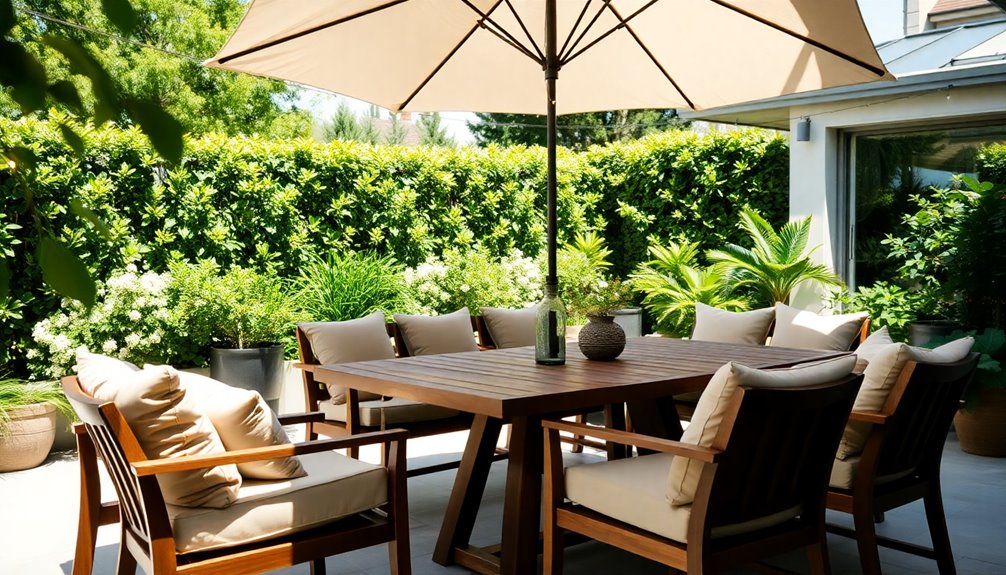
With your budget in place, it's time to consider how your outdoor furniture can reflect your style and enhance your space. Sustainable materials, like recycled plastics and reclaimed wood, not only add rustic charm but also offer durability and environmental benefits. Increased use of recycled materials is a growing trend that aligns with eco-friendly practices in outdoor furniture design. Incorporating outdoor elements that promote emotional well-being can further enhance your relaxation space.
If you prefer a sleek look, minimalist designs with neutral colors and clean lines can create an uncluttered outdoor atmosphere. For a nostalgic touch, vintage styles like classic wicker and metal gliders bring timeless elegance. You might also explore innovative combinations, such as aluminum with rope or synthetic rattan, which provide both durability and versatility. Embrace these trends to curate an outdoor oasis that suits your lifestyle and aesthetic preferences.
Frequently Asked Questions
How Do I Choose Furniture for Small Outdoor Spaces?
To choose furniture for small outdoor spaces, start by measuring your area accurately and sketching a layout.
Opt for multifunctional pieces, like benches with storage or collapsible tables, to maximize utility.
Select lighter colors and materials that create an airy feel while ensuring durability.
Arrange larger items first against walls, leaving pathways for movement.
Finally, maintain some empty space to keep the area inviting and free of clutter.
What Are the Best Colors for Outdoor Furniture?
Did you know that colors can influence mood by up to 80%?
When choosing the best colors for outdoor furniture, consider coastal blues for a calming vibe or natural neutrals for timeless elegance.
If you want to energize the space, bold pops of color like sunny yellows can add excitement.
Earthy tones also work wonders, connecting your furniture to nature while creating a warm, inviting atmosphere.
Choose what resonates with your style!
Can I Use Indoor Furniture Outside Temporarily?
Yes, you can use indoor furniture outside temporarily, but it's not ideal for long-term exposure.
Indoor furniture isn't built to withstand outdoor elements, so you'll want to protect it from sunlight and moisture. Use umbrellas or place it under covered areas to minimize damage.
Make sure to clean it properly and apply a sealant for added protection. Regularly inspect for wear, and recoat as needed to extend its lifespan.
How Do I Prevent Outdoor Furniture From Fading?
Did you know that UV rays can cause up to 90% of fading in outdoor furniture?
To prevent your furniture from fading, consider using UV-resistant materials like HDPE plastic. Regularly apply a UV protectant spray to block harmful rays, and use protective covers when not in use.
For wooden pieces, apply a UV-resistant sealant annually. These steps will keep your outdoor furniture looking vibrant and extend its lifespan significantly.
What Styles Are Currently Trending for Outdoor Furniture?
Right now, vibrant hues and natural materials are trending in outdoor furniture styles.
You'll find bold color palettes like Marine Blue and Terracotta adding personality to spaces.
Soft seating with plush cushions bridges indoor elegance with outdoor comfort, while materials like synthetic rattan and bamboo offer durability without sacrificing aesthetic appeal.
Mixing and matching these elements can create a stunning outdoor area that reflects your style and enhances your enjoyment of the outdoors.
Conclusion
By considering your space, choosing the right materials, and prioritizing comfort, you're setting the stage for outdoor relaxation. Embrace styles that reflect your personality, plan for maintenance that fits your lifestyle, and account for the climate to ensure longevity. Set a budget that makes sense for you, and explore design trends that inspire. With these steps, you'll create an outdoor oasis that's not just functional but also a true extension of your home. Enjoy your perfect retreat!
